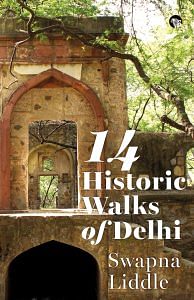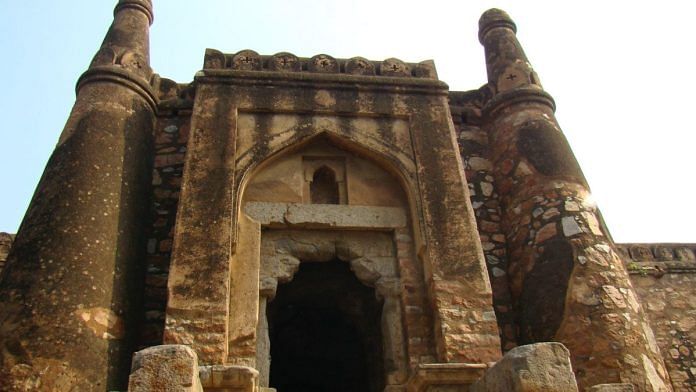Jahanpanah was soon abandoned as a capital city, as Mohammad Tughlaq’s successor, Firoz Shah, built a new capital at Firozabad, in the area we now know as Firoz Shah Kotla. Satpula ceased to have a defensive importance, but it continued to be significant in its new role. For many centuries, the water of the pool was considered holy and was believed to cure many illnesses. Bathing in the water was also believed to protect against evil spirits. Till late into the nineteenth century, there used to be a big annual fair here just before Diwali, when people would come for a holy dip and even take some of the water away with them.
The rooms in the bastions were for some time also used as a school, giving the building an alternate name—the Madrasa. By the early twentieth century, the Archaeological Survey of India took it upon itself to protect and conserve the building, at which time probably the local ritual practices and social functions associated with this building were stopped.
Climbing down from the dam, and leaving the building behind, turn right and walk along the main road. You will notice that to your right, there is a slight rise in the ground, forming a ridge that runs parallel to the road. This is the remains of the city wall. Soon you will come to Khirki village, and to your right, you can glimpse a fort-like stone building set somewhat back from the road. This is the Khirki mosque.
The Khirki mosque is the most unusual mosque in Delhi and has some unique features. From the outside, the corner towers look like the bastions of a fort. The pillars on either side of each gateway remind one of the Qutub Minar (particularly those flanking the eastern entrance)—a fairly common device that was carried into later Lodi times. The heavy jalis of the windows give it a barred appearance. There is an overall suggestion of defensive architecture and it reminds us of how the Mongol invasions had coloured the view of the Tughlaq builders.
No date is to be found inscribed on the mosque or mentioned in histories of the period, so one has to make educated guesses about its possible date. It is most probable that a mosque of this size would have been built to serve a large population, which puts the date within the heyday of Jahanpanah. We do know that Mohammad Shah Tughlaq built a large congregational mosque, the Begampur mosque, in the heart of Jahanpanah, next to his own palace. He is not likely to have built another large mosque so close to the congregational mosque. It is therefore more likely that the Khirki mosque was built in Firoz Shah’s reign but when Jahanpanah was still flourishing. This was probably in the early 1350s or the first few years of the emperor’s reign, before the establishment of Firozabad.
The mosque is built in two storeys. The lower one consists of arched cells running all around the building, opening to the outside. On three sides of the building—north, south and east—steps lead up to the second storey, which is the mosque proper. The entrance of the mosque closest to the road is the southern one. Inside, the mosque continues to surprise. It is mostly filled with pillared arcades. There are just four open courtyards, occupying less than a fifth of the total area. Such an arrangement is unusual in India where the typical plan for a mosque is a large open courtyard. Drains slope away from the open courtyards to the edges of the building, to carry away rainwater entering the open court. There are carved brackets that support a chhajja all along the edge of the roof around each courtyard. The screen windows and the open courtyards let in some light, but the western side which is in the direction of Mecca is entirely closed and therefore particularly gloomy.
In the north-eastern corner of the building, the roof has fallen in as a result of a fire in the late eighteenth century. At that time of the fire, the building was not functioning as a mosque. Those were politically troubled times in Delhi. The Mughal Empire was weak and the city and the surroundings were prey to marauding bandits. This led the population from the surrounding villages to take shelter within the solidly built mosques and tombs of the older cities of Delhi. This happened to the Khirki mosque too, which had long ceased to be used as a place of worship—probably when the Tughlaq dynasty came to an end in the early fifteenth century. In the middle of the nineteenth century, it was reported that 134 people and 147 head of cattle were living in the mosque. The north-western corner was used to store fodder that had earlier caught fire, which led to the damage. Sometime in the second half of the nineteenth century, the local British government ordered the inhabitants to be evicted from the mosque.
Just within the eastern entrance there are steps that lead to the roof. The sight here is spectacular, as the roof is covered with domes, arranged in nine clusters of nine, and one extra dome over the middle of each of the four sides of the mosque.
Leave the mosque by the southern entrance, turn right and walk around the perimeter of the enclosure to the northernwestern corner of the mosque. Here, there is a narrow lane that goes off to the left. Take this and it will eventually bring you to Khirki Main road. Turn right onto this road and walk about 250 metres. You will come to a fenced area on your right which contains some old buildings. The most prominent among these is the tomb of Yusuf Qattal.
 Extracted from the revised and updated edition of 14 Historic Walks of Delhi by Swapna Liddle. Published by Speaking Tiger Books, 2023.
Extracted from the revised and updated edition of 14 Historic Walks of Delhi by Swapna Liddle. Published by Speaking Tiger Books, 2023.



